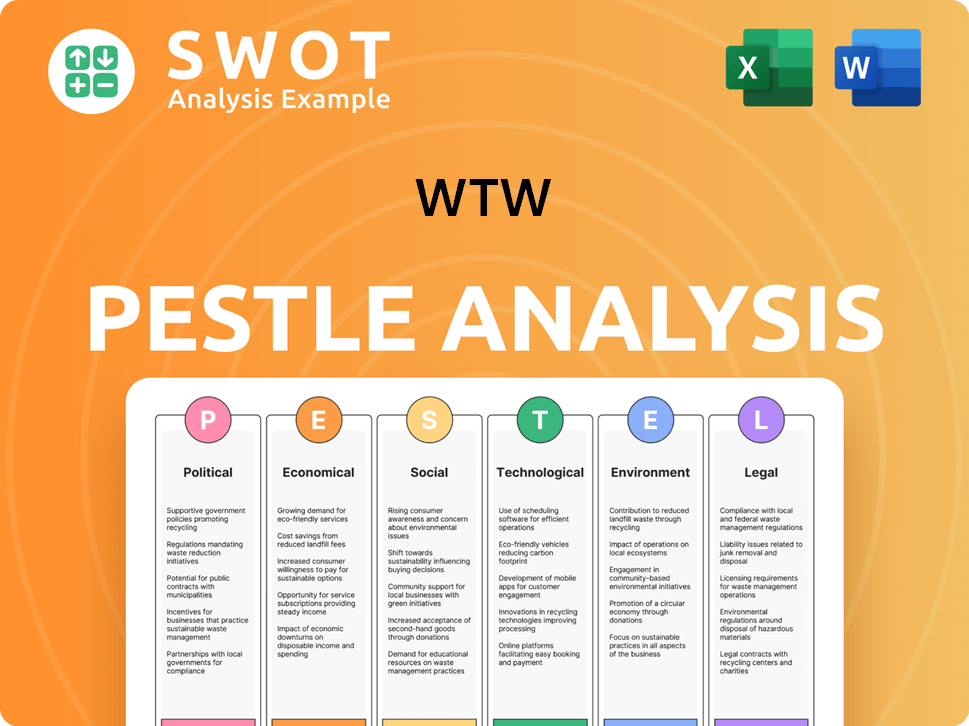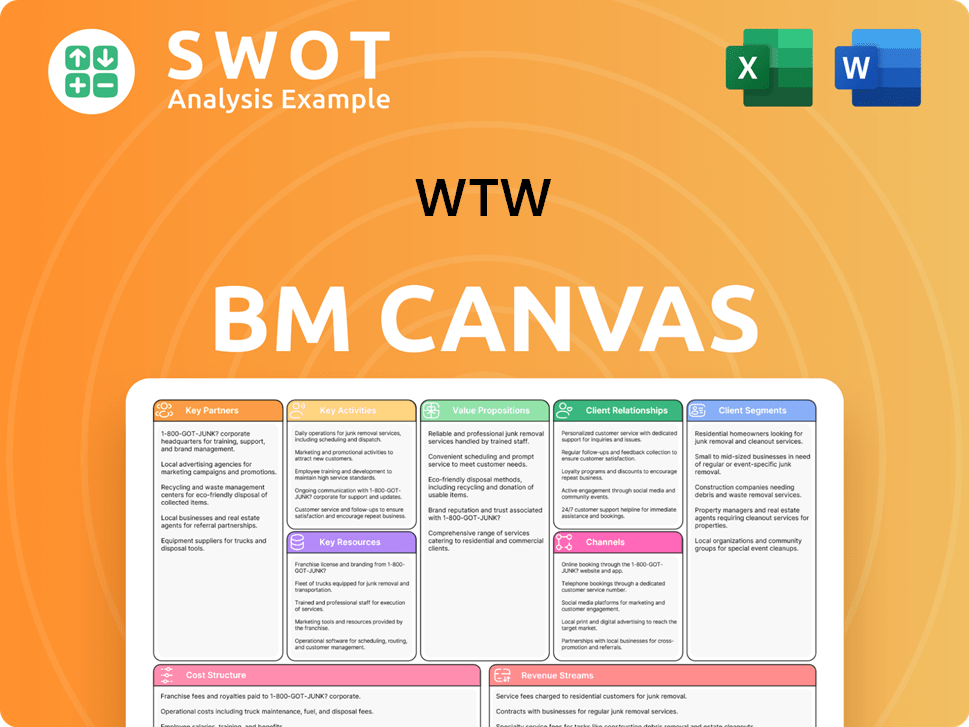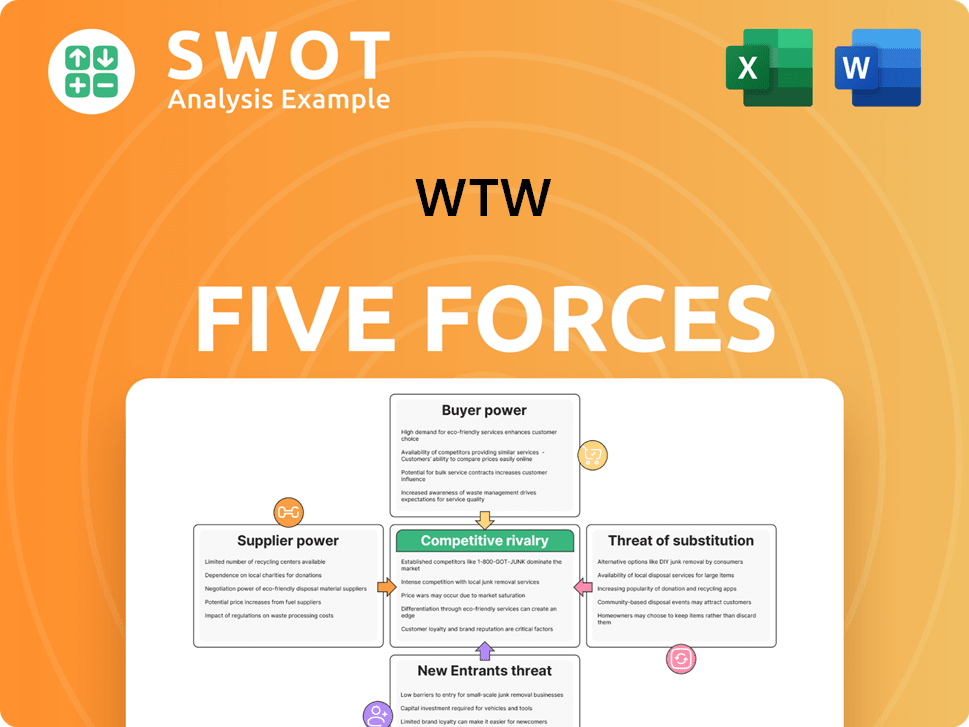WTW Bundle
How is WTW Redefining Sales and Marketing in 2025?
WTW, a global leader in advisory, broking, and solutions, is constantly adapting its WTW SWOT Analysis to stay ahead. Its recent reintroduction of legacy brand names alongside its official "WTW" branding signals a dynamic approach to market penetration. This strategic move, coupled with a focus on accelerating performance and optimizing its portfolio, showcases the company's commitment to innovation.

This deep dive into WTW's sales and marketing strategy will explore how the company navigates the complex consulting landscape. We'll examine its sales and marketing integration, from lead generation strategies to customer relationship management, and uncover how WTW's strategic planning fuels its success. Understanding WTW's approach provides valuable insights for financial professionals and business strategists alike, offering a clear view of its competitive advantages and future direction.
How Does WTW Reach Its Customers?
The core of the WTW company strategy for sales revolves around a direct sales model. This approach is primarily used to engage with its corporate and institutional clients. This strategy allows for tailored advisory services and solutions, especially in complex areas such as risk management and talent strategies.
WTW's sales team directly serves approximately 22,000 corporate clients across 140 countries. This extensive global reach, combined with local expertise, allows WTW to deliver solutions directly to clients worldwide. The company's focus on direct engagement is a key element of its sales process overview.
The company's approach to sales and marketing integration has evolved to include strategic partnerships and inorganic growth opportunities. These moves enhance its core direct sales efforts, broadening its service offerings and market reach.
WTW's primary sales channel is its direct sales team, focusing on corporate and institutional clients. This allows for personalized service and tailored solutions. This approach is central to WTW's sales strategy for insurance and consulting services.
WTW has expanded its reach through strategic alliances. In December 2024, a joint venture with Bain Capital was announced to re-enter the treaty reinsurance broking market. In October 2024, a co-brokerage arrangement was established with J. Morey Co. Inc.
WTW explores inorganic growth opportunities to enhance its market position. The Bain Capital joint venture exemplifies this, aiming to boost market share in reinsurance broking. This approach complements the company's direct sales efforts.
WTW integrates technology to support its sales and service offerings. A partnership with Kayna and Vibrant in November 2024, supports third-party vendor cybersecurity insurance compliance. This integration streamlines policy generation and provides real-time alerts.
WTW's sales strategy is built on a direct sales model, supplemented by strategic partnerships and technology integration. This approach allows for comprehensive service offerings and market expansion. These strategies are crucial for WTW's competitive analysis.
- Direct Sales: Focused on personalized client engagement with a global presence.
- Strategic Partnerships: Collaborations to expand market reach and service offerings.
- Technology Integration: Enhancing service delivery through technology.
- Inorganic Growth: Joint ventures and acquisitions to strengthen market position.
WTW SWOT Analysis
- Complete SWOT Breakdown
- Fully Customizable
- Editable in Excel & Word
- Professional Formatting
- Investor-Ready Format

What Marketing Tactics Does WTW Use?
The sales and marketing strategy of WTW, also known as Willis Towers Watson, centers on a blend of digital and traditional marketing tactics. This approach aims to build brand awareness, generate leads, and ultimately drive sales within its core corporate and institutional client base. The company's strategy is designed to engage a sophisticated audience with relevant and insightful content.
A key element of the WTW marketing strategy is content marketing, which is evident through the regular release of reports and insights. WTW's marketing efforts incorporate data-driven techniques and personalization to enhance client engagement. This multifaceted approach allows WTW to maintain a strong presence in the market and effectively communicate its value proposition.
WTW's approach to sales and marketing integration is designed to provide a cohesive customer experience. Their strategies are designed to align with the needs of their target market, focusing on thought leadership and targeted engagement. For example, the company launched new insights for 2025, including a podcast on global marketplace insights and articles on political violence coverage and tariffs impact.
WTW heavily utilizes content marketing, producing numerous reports and insights to establish thought leadership. This includes reports like the 'Global Directors' and Officers' Survey Report 2024/2025,' which highlights key risks. Content marketing is a core component of the Growth Strategy of WTW.
The company leverages data-driven marketing and personalization to enhance client engagement. In January 2025, WTW highlighted the use of data to justify investments in total rewards, including employee-facing technology, data, analytics, and AI.
WTW actively participates in industry events, such as the SuperReturn International event in 2025, to engage with its target audience. This participation supports their thought leadership and facilitates targeted engagement with potential clients.
WTW demonstrates innovation by leveraging technology within its marketing and client solutions. The recent launch of an AI-driven monitoring tool for insurers in March 2025 showcases this commitment to technological advancement.
The company focuses on targeted engagement with its core corporate and institutional client base. This approach ensures that marketing efforts are directed towards the most relevant audiences, maximizing the impact of their campaigns.
WTW emphasizes thought leadership through the consistent output of expert-led content. This strengthens their position as a trusted advisor and helps attract and retain clients in a competitive market.
WTW employs a variety of marketing tactics to achieve its business objectives. These tactics are designed to build brand awareness, generate leads, and drive sales. The integration of these tactics is central to the WTW company strategy.
- Content Marketing: Regular publication of reports, insights, and articles.
- Data-Driven Marketing: Utilizing data to personalize and target marketing efforts.
- Industry Events: Participation in events to engage with the target audience.
- Technological Innovation: Implementing new technologies like AI for client solutions.
- Targeted Engagement: Focusing marketing efforts on the core client base.
- Thought Leadership: Establishing expertise through content and insights.
WTW PESTLE Analysis
- Covers All 6 PESTLE Categories
- No Research Needed – Save Hours of Work
- Built by Experts, Trusted by Consultants
- Instant Download, Ready to Use
- 100% Editable, Fully Customizable

How Is WTW Positioned in the Market?
WTW positions itself as a leading global advisory, broking, and solutions company. Their brand positioning focuses on providing data-driven, insight-led solutions across people, risk, and capital. This approach is designed to help clients improve business performance by managing risk, optimizing benefits, cultivating talent, and expanding capital.
The company emphasizes innovation and expertise, as demonstrated by its development of new open-access risk modeling tools. This commitment is further highlighted by initiatives like the School of Risks, which saw a 40% increase in student enrollment from 2024 to 2025. This growth underscores WTW's dedication to thought leadership and continuous improvement in its service offerings.
A key element of WTW's brand is its emphasis on partnership and collaboration. They work 'shoulder to shoulder' with clients to identify opportunities for sustained success. In 2025, WTW is reintroducing Willis and Towers Watson as trading names to leverage the strong recognition of its legacy names. This strategic move acknowledges market sentiment while maintaining 'WTW' as the official corporate brand. Learn more about the Revenue Streams & Business Model of WTW.
WTW's primary message revolves around helping clients improve their business performance by managing risk, optimizing benefits, and cultivating talent. This focus is central to their overall WTW sales strategy.
WTW targets a diverse audience, including businesses, governments, and institutions. Their solutions are tailored to meet the specific needs of each client, making their WTW marketing strategy highly adaptable.
The company's visual identity and tone of voice consistently reflect professionalism, authority, and a client-centric approach. This consistency is crucial for effective brand positioning.
The reintroduction of Willis and Towers Watson as trading names is a strategic move to leverage legacy recognition. This approach is part of their broader WTW company strategy to maintain market relevance.
WTW Business Model Canvas
- Complete 9-Block Business Model Canvas
- Effortlessly Communicate Your Business Strategy
- Investor-Ready BMC Format
- 100% Editable and Customizable
- Clear and Structured Layout

What Are WTW’s Most Notable Campaigns?
The company's sales and marketing efforts are significantly shaped by its strategic priorities and specific product launches. The 'Grow, Simplify and Transform' strategy, implemented over the last few years, has been a cornerstone of its approach. This overarching framework has guided the company's investments and operational improvements.
In 2024, the 'Grow, Simplify and Transform' strategy contributed to a 5% increase in full-year revenue, reaching $9.9 billion. This success has set the stage for a new strategy aimed at accelerating performance and optimizing the portfolio. Several targeted campaigns also play a crucial role in driving growth and market penetration. These campaigns highlight the company's focus on innovation and customer-centric solutions, which are integral to its overall WTW target market approach.
The company's strategic initiatives and product launches demonstrate a commitment to adapting to market needs and enhancing its service offerings. These efforts are crucial components of the overall WTW sales strategy and WTW marketing strategy.
This multi-year strategy focused on strategic investments, streamlining operations, and transforming the cost structure. It aimed to revitalize the company through investments in talent and technology. The result was increased profitability and faster growth.
Launched in the U.S. in January 2025, following a 2024 launch in the UK and Canada. It is designed to provide asset managers with a unified management and professional policy. The campaign uses press releases and direct client engagement to drive adoption.
Launched in March 2025, AdWrap is a master-controlled insurance program for marketing and advertising production in the U.S. It offers cost-effective and transparent production insurance to businesses and their vendors. This initiative expands market reach.
The company utilizes press releases, direct client engagement, and other channels to promote its offerings. Success is measured by adoption rates and positive client feedback. These efforts drive the WTW company strategy.
The campaigns highlight the integration of sales and marketing efforts. This alignment ensures consistent messaging and a unified approach to customer engagement, which is critical for WTW sales strategy.
The 'Grow, Simplify and Transform' strategy exemplifies strategic planning. It provides a framework for long-term growth and market adaptation. This strategic vision is vital for the company's success.
The IMI Plus and AdWrap campaigns demonstrate a targeted sales strategy for the insurance sector. These product-specific initiatives address the needs of asset managers and businesses in marketing and advertising.
The company's marketing approach focuses on simplifying complex insurance needs. This simplification enhances operational efficiency for clients. This is a key element of WTW marketing strategy.
Examples include the IMI Plus launch and the AdWrap program. These campaigns are designed to expand market reach and address specific industry needs. These campaigns showcase WTW's marketing efforts.
The company focuses on providing solutions that simplify complex insurance needs. This approach enhances operational efficiency for clients. This customer-centric approach is central to their strategy.
WTW Porter's Five Forces Analysis
- Covers All 5 Competitive Forces in Detail
- Structured for Consultants, Students, and Founders
- 100% Editable in Microsoft Word & Excel
- Instant Digital Download – Use Immediately
- Compatible with Mac & PC – Fully Unlocked

Related Blogs
- What are Mission Vision & Core Values of WTW Company?
- What is Competitive Landscape of WTW Company?
- What is Growth Strategy and Future Prospects of WTW Company?
- How Does WTW Company Work?
- What is Brief History of WTW Company?
- Who Owns WTW Company?
- What is Customer Demographics and Target Market of WTW Company?
Disclaimer
All information, articles, and product details provided on this website are for general informational and educational purposes only. We do not claim any ownership over, nor do we intend to infringe upon, any trademarks, copyrights, logos, brand names, or other intellectual property mentioned or depicted on this site. Such intellectual property remains the property of its respective owners, and any references here are made solely for identification or informational purposes, without implying any affiliation, endorsement, or partnership.
We make no representations or warranties, express or implied, regarding the accuracy, completeness, or suitability of any content or products presented. Nothing on this website should be construed as legal, tax, investment, financial, medical, or other professional advice. In addition, no part of this site—including articles or product references—constitutes a solicitation, recommendation, endorsement, advertisement, or offer to buy or sell any securities, franchises, or other financial instruments, particularly in jurisdictions where such activity would be unlawful.
All content is of a general nature and may not address the specific circumstances of any individual or entity. It is not a substitute for professional advice or services. Any actions you take based on the information provided here are strictly at your own risk. You accept full responsibility for any decisions or outcomes arising from your use of this website and agree to release us from any liability in connection with your use of, or reliance upon, the content or products found herein.